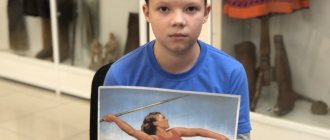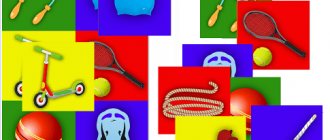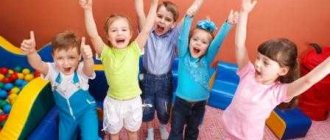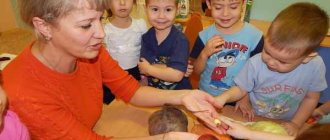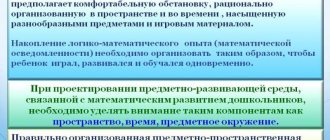“Organization of recreational work during the day with preschool children”
Organization of recreational work during the day
with preschool children
The goal of health work in preschool educational institutions is to preserve and strengthen the physical and mental health of children, improve their physical development, and introduce them to a healthy lifestyle.
Health activities in kindergarten allow the child to cope with the difficulties of getting used to a new environment, allow them to organize the child’s life in a preschool institution in such a way that leads to the most adequate, almost painless adaptation to new conditions, and the formation of a positive attitude towards all types of everyday life.
Wellness activities take an integrated approach and are built on three main areas:
- Creation of a healthy environment for the prevention of various deviations in psychophysical development in children (vision, flat feet, poor posture, articulation apparatus, breathing).
- Formation of a healthy lifestyle for children in kindergarten and at home.
- Development of physical qualities of preschool children.
The deterioration of children's health dictates the need to develop and implement health-improving measures aimed at improving children's health and reducing their morbidity.
Mode
– this is the correct distribution in time and the correct sequence in satisfying the basic physiological needs of the child’s body: sleep, eating, wakefulness. The correct regime ensures a balanced, cheerful state of the child, protects the nervous system from overwork, and creates favorable conditions for the physical and mental development of the child. If this most important condition is not met, deviations in the child’s behavior, whims, increased and decreased excitability, poor sleep, lack of appetite, etc. can be observed.
The daily routine of preschool children is based on the fact that children sleep only once during the day for 2-2.5 hours, the time of active wakefulness is extended to 6-7 hours, and their night sleep is 10 hours.
In a preschool institution, the daily routine is structured in accordance with the age of the children. It is necessary that parents understand the importance of this particular condition for the child’s health. Unfortunately, in many families, especially young ones, the regime is neglected, and this inevitably harms the child.
According to many observations, children attending preschool institutions most often get sick after weekends and holidays. And this happens because the child is not provided with the routine to which he is accustomed, to which he was tuned in in kindergarten: they go to bed later in the evening, daytime naps are canceled, walks are replaced with games at home, and they are allowed to watch TV shows as much as they want.
All this affects the fragile child’s body, the functions of all its organs and systems deteriorate, thereby inevitably weakening the protective mechanisms. The child's preschool regime at home should be a continuation of the kindergarten regime; without this, it is difficult to expect success from hardening.
The system of health-improving measures is reflected in the content of health-improving work with preschool children:
I. Motor activity
- Morning exercises for the overall development of the child are carried out every morning.
- Physical education and health classes – 3 times a week (2 times indoors and 1 time for a walk).
- Active and dynamic games - every day during the day.
- Physical exercises.
- Gymnastics after a nap - every day.
- Preventive gymnastics (prevention of scoliosis and poor posture, prevention of flat feet, eye gymnastics) - daily.
- Breathing exercises - daily.
- Walks - daily.
II. Hygiene and water procedures:
- Washing and washing hands daily.
- Games with water – once a week.
- Compliance with the drinking regime - daily.
- Air recirculation and disinfection – daily.
III. Using the natural environment for hardening activities:
- Ventilation of premises - daily.
- Sleeping with the transom open - every day in the summer.
- Walks in the fresh air - daily.
- Providing light conditions.
IV. Hardening:
- Walking barefoot. The main point of walking barefoot is to harden the skin of the feet to the effects of low temperatures, mainly the floor and earth.
- Rinse your mouth with cool water daily.
- Air baths.
- Reasonable clothing.
V. Balanced meals 5 times a day.
VI. Fortification, including vitamin “C” in the third dish.
VII. Working with parents on children's health issues:
- Individual conversations.
- Consultations.
- Parent meetings.
- Health corners.
- Mobile folders.
Thus, the main thing is to teach children from a very early age to value, protect and strengthen their health. This is a cheerful, active, friendly, inquisitive child. The development of the child’s physical qualities proceeds harmoniously. He is durable, fast enough, agile and strong. The mode of his life activity is carried out in accordance with the individual biorhythmological portrait with an optimal ratio of periods of ups and downs of activity, wakefulness and sleep. He is not afraid of unfavorable weather factors or sudden changes in them, since he is hardened, his thermoregulation system is well trained to multidirectional temperature influences, so he does not know what a cold is. Thanks to a balanced diet, this child does not have excess body weight, he has every opportunity for normal harmonious growth and development. Favorable psychological conditions in the family and in the preschool institution contribute to the strengthening of his mental health. The task of all of us, adults, is to create conditions for raising such children.
Forms of physical education and health work in preschool educational institutions
One of the main tasks in a preschool institution is to protect and strengthen the health of children, comprehensive physical development and hardening of the body. In our kindergarten, a system of physical education and health work has been created, which contributes to the formation of a healthy, strong, seasoned, cheerful, responsive, proactive child, who has good control of his movements, loves sports and physical exercise, and is capable of learning at school and for active subsequent creative activities. For this purpose, all conditions have been created that meet the medical and educational requirements for preserving and strengthening the health of children. Kindergarten teachers use various forms of physical education and health work with children, taking into account their level of development and health status. Physical education in a preschool institution is carried out not only in educational activities in physical education, but also in everyday life. Several forms of physical education and recreational work are carried out every day throughout the day. [4.32]
Morning exercises.
Morning exercises are a gradual introduction of the body into favorable physical activity. In kindergarten, gymnastics is one of the routine moments. And a means to raise the emotional tone of children. To increase children’s interest in morning exercises and diversify physical activity, we change its form and location.
Along with traditional morning exercises, different types and variants of it can be introduced into the practice of preschool institutions, both in terms of content and in methods of implementation. We offer different options. Morning gymnastics of a play nature includes 2–3 outdoor games or 5–7 play exercises of an imitation nature “Morning in the Forest”, “Kolobok”, as well as varying degrees of intensity, which are performed as a set of exercises with a general developmental effect. Exercises on an obstacle course - children can be offered exercises with a gradual increase in load: increasing the complexity of motor tasks with the inclusion of different basic types of movements, increasing the number of repetitions, increasing the tempo of movements, changing the alternation of physical education exercises: “Who is first”, “Through the swamp”. Morning exercises can be carried out in the form of a health jog. This type of morning exercises must be carried out in the air - for 5–7 minutes. continuous running at an average pace with a gradual increase in distance and time. At the end of the gymnastics, breathing exercises are offered. A set of musical and rhythmic exercises (consisting of a warm-up, 5–6 basic developmental exercises in dance movements.)
The content of morning exercises includes various formations and formations, various types of walking, running, jumping with a gradual increase in the motor activity of children. Exercises for balance and coordination development, outdoor games and basic developmental exercises are offered.
The complex of morning exercises should be repeated for two weeks.
In older preschool age, children must independently reproduce the entire complex after 2-3 repetitions. During the organization, musical accompaniment is necessary. [8.58]
Physical education minute
Physical education minutes - short-term physical exercises - are carried out in the middle, senior and preparatory groups during breaks between classes, as well as during classes that require intellectual stress (speech development, drawing, mathematics, etc.) It is well known that physical education minutes are used to maintain mental performance at good level. At the moment when children’s attention decreases and motor restlessness appears (usually for 12–15 minutes), fatigue sets in, you can offer several physical exercises standing at their tables or in a free place in the group “Chopping wood”, “Clocks” ", "Diving". These are general developmental exercises: bending the torso, moving the arms up and to the sides, half-squats and squats, bouncing, skipping, walking. A physical education lesson may be accompanied by text related or not related to the movement of the lesson. When pronouncing a text by children, it is necessary to ensure that they exhale when pronouncing the words of one line, and take a deep and calm breath before the beginning of the next line. After physical education, the child’s breathing remains calm. You can conduct physical education with musical accompaniment, during which children can perform dance exercises or improvised movements.
Motor warm-up (dynamic pause) is carried out during a long break between classes, allowing you to actively relax after mental stress and forced posture. It consists of 3-4 exercises, as well as voluntary movements of children using a variety of physical education aids. At the end of the warm-up, it is rational to do a relaxation exercise for 1–2 minutes. Warm-up duration is no more than 10 minutes. [2,112]
Outdoor games, physical exercises while walking. Outdoor games are complex motor, emotionally charged activities. Outdoor games serve as a method of improving motor skills already mastered by children and developing physical qualities. Outdoor games are divided by content into outdoor games with rules and sports games.
Awakening gymnastics. After a nap, it is important to improve the mood and muscle tone of each child, as well as take care of the prevention of posture and foot disorders. This can be facilitated by a complex of gymnastics after daytime sleep, which is variable in nature; depending on this, its duration will also change (from 7–15 minutes).
A set of exercises is carried out in bed. Children gradually wake up to the sounds of melodic music, lying in bed, for 3-4 minutes, perform 4-5 general developmental exercises. You can offer exercises from various positions: lying on your side, on your stomach, sitting. After this, the children walk, gradually turning into running - they run out of the bedroom into a well-ventilated group with a temperature of 17-19 degrees, after which they move on to the massage paths. Children study in their underpants and barefoot. After performing various variations of gymnastics, they move on to water hardening procedures: wiping with a damp mitten, followed by rubbing with a dry towel. In our preschool institution, much attention is paid to hardening procedures, which have a particular effect on improving health and reducing morbidity.
Hardening is the most important part of the physical education of preschool children. The best means of hardening are the natural forces of nature: air, sun and water. The purpose of hardening is to develop the body’s ability to quickly bring the functioning of organs and systems into line with the changing external environment. As a result of hardening, the child becomes less susceptible to sudden changes in temperature and colds and infectious diseases. Seasoned children have good health and appetite, are calm, balanced, cheerful, cheerful, and highly productive. Such results can be achieved only with the correct implementation of hardening procedures.
Positive results from hardening procedures can only be expected if such principles as gradualism, consistency, systematicity, complexity, taking into account the individual characteristics of each child are observed, as well as an active and positive attitude of children towards hardening procedures.
Air hardening is the most accessible means of hardening at any time of the year. Systematic exposure of a child to the air helps the body adapt more quickly to changing temperature conditions. The positive effects of air baths increase if combined with physical exercise. In addition to organized physical education activities in the daily routine of children of senior preschool age, independent motor activity should occupy a significant place. However, here too, children’s actions largely depend on the conditions created by adults. With proper guidance of independent activities, you can significantly influence the variety of games and movements without suppressing the initiative of the child himself.
Independent motor activity of children is organized at different times of the day: in the morning before breakfast, between classes, during play hours after naps and during walks (morning and evening). Active actions of children should alternate with calmer activities. It is important to take into account the individual characteristics of each child and his well-being.
When planning independent activities, it is important to take care of creating a physical education and play environment (space sufficient for movement, variety and rotation of aids and toys), and allocate special time in the daily routine for children to play independently. To create diversity and novelty in the physical education and gaming environment, the teacher can introduce various physical education aids during the day and group them in different ways. This avoids monotony of movements and promotes the all-round development of children.
The teacher must influence the children’s choice of appropriate exercises and games, providing them with the necessary equipment, manuals, and explaining the methods of movement. It teaches children to play together, encourages more dexterous children who have good command of movements to help their peers.
Finger games are a very important part of developing fine motor skills. These games are very emotional and exciting. They promote the development of speech and creative activity. Finger games seem to reflect the reality of the surrounding world - objects, animals, people, their activities, natural phenomena. During finger games, children, repeating the movements of adults, activate hand motor skills. This develops dexterity, the ability to control one’s movements, and concentrate attention on one type of activity.
Finger games are the staging of any rhymed stories or fairy tales using the fingers. Many games require the participation of both hands, which allows children to navigate the concepts of “right”, “left”, “up”, “down”, etc. [7,52]
Breathing exercises can be performed during morning exercises, exercises after waking up, or while walking.
At first, breathing exercises seem to be one of the most difficult for children. And it is all the more important to help children by turning boring exercises into a fun game.
You should not set a goal to complete all the exercises at once. You can perform several well-known ones, gradually supplementing them with new ones, or change them, dividing them by day of the week.
By teaching your preschooler simple and fun breathing exercises, you will make an invaluable contribution to his health + prevention of ARVI.
Eye exercises are used for preventive and health purposes to prevent visual fatigue in children. A set of eye gymnastics exercises is performed to music for 3–5 minutes. It includes up to 5 exercises, including massage exercises, rubbing, eye strain relief, and attention exercises.
Literature:
- Afonin, I. How beautiful this world is / I. Afonin. - St. Petersburg: Peter, 2006. - 206 p.
- Bogina, L. Health protection of children in preschool institutions: methodological manual / L. Bogina. - M.: Mozaika-Sintez, 2005. - 112 p.
- Buzunova, A. Medical and pedagogical health work / A. Buzunova, P. Volkov. // Preschool education. - 2003. - No. 4. - P. 64.
- Vavilova, E. N. Teach to jump, run, climb, throw / E. N. Vavilova. - M.: Education, 2003. - 174 p.
- Veselaya, Z. A. The game accepts everyone / Z. A. Veselaya. - Minsk: Polymya, 2007. - 58 p.
- Golitsyna, N. S. Non-traditional physical education classes in a preschool educational institution / N. S. Golitsyna. - M.: Scriptorium 2003, 2003. - 72 p.
- Golubeva, G. N. Program - “Be healthy!” (research program to strengthen the health of children in preschool educational institutions) / G. N. Golubeva. - Nab. Chelny: Salad 1999. - 32 p.
- Gorkova, L.G. Physical education classes in preschool educational institutions: Main types, scenarios of classes / L.G. Gorkova, L.A. Obukhova. - M.: 5 for knowledge, 2005. - 38–40, 55 p.
System of health-improving and preventive work in kindergarten
Explanatory note
For effective, high-quality implementation of work on improving the health of kindergarten students and instilling in them a healthy lifestyle, it is necessary to develop a long-term action plan, which will clearly trace the system of work in this direction, the interaction of the institution’s employees responsible for health-improving and preventive measures. Such planning makes it possible to track children’s attendance at health-improving kindergartens. We manage two such kindergartens. Planning also helps in compiling an analysis of the incidence of children, monitoring the passage of medical care. inspection, etc., in the conduct of sanitary educational work. We are happy to share our planning with colleagues.
Plan for health and preventive work of the kindergarten "" for the 20th... year
| No. | Events | Dates | Responsible | Note |
| Organizational events | ||||
| 1. | Monitoring the incidence rate. | monthly | senior nurse | |
| 2. | Monitoring the health status of children entering the Kindergarten (new arrivals, after vacation, after illness). | as children arrive | senior nurse | |
| 3. | Monitoring the medical examination of kindergarten employees. | constantly | senior nurse | |
| Preventive actions | ||||
| 1. | Preparation of medical documentation, design of “Health Corners” in groups and the medical block. | September | senior nurse, group teachers | |
| 2. | Analysis of children's morbidity. | monthly | senior nurse | |
| 3. | Selection of a contingent of children from among the children's children for health improvement in kindergartens “Snow White” and “Morozko”. | quarterly | senior nurse, pediatrician | |
| 4. | Monitoring compliance with the sanitary and hygienic regime in the kindergarten and the sanitary condition of the premises of the kindergarten and site. | during a year | senior nurse, deputy head of medical care | |
| 5. | Monitoring the organization of meals and the implementation of an individual approach to children during meals. | during a year | head of d/s, senior nurse. | |
| 6. | Organization of dietary nutrition according to the indications of specialist doctors. | during a year | senior nurse | |
| 7. | Organization and holding of the “Week of National Cuisine”. | October | head of d/s, senior nurse, chef | |
| 8. | Interaction with specialists from kindergartens UDP LLC Gazprom Dobycha Urengoy “Snow White”, “Morozko”. | during a year | head of d/s, senior nurse | |
| 9. | Health activities: *C-vitaminization of third courses; *rinsing the mouth with boiled water and herbal decoctions; *multivitaminization; *herbal teas, licorice root syrup, rose hip syrup, etc.; *lubricating the nasal mucosa with oxolinic ointment. | daily, autumn-winter period during the winter period | senior nurse | |
| 10. | Providing prevention in children's activities: *breathing exercises; *articulation gymnastics; *formation of speech breathing; *prevention of flat feet and poor posture; *prevention of violations of the emotional-volitional sphere; *preventive work with children with visual impairments. | during a year | speech therapist, physical education instructor, educational psychologist, educators | |
| 11. | Organization of in-depth preventive examinations of children of maternity age with the involvement of specialized specialists (ophthalmologist, dentist). | during a year | senior nurse | |
| 12. | Observation of a dispensary group of children. | during a year | senior nurse | |
| 13. | Monitoring the organization of hardening activities. | during a year | senior nurse | |
| Anti-epidemic measures | ||||
| 1. | Planning and monitoring the implementation of preventive vaccinations in accordance with the national vaccination calendar and according to epidemic indications. | during a year | senior nurse | |
| 2. | Carrying out anti-epidemic quarantine measures in cases of infectious disease in the kindergarten. | during the quarantine period | senior nurse | |
| 3. | Carrying out preventive measures in unfavorable epidemic conditions. | during epidemics and seasonal morbidity | senior nurse | |
| Catering | ||||
| 1. | Organization of children's meals in accordance with SanPiN 2.4.1.3049-13. | during a year | head of d/s, senior nurse, chef | |
| 2. | Organization and holding of the “Week of National Culture”. | October | head of d/s, deputy head of medical and medical care, senior medical officer, chef | |
| 3. | Serving buffet breakfasts. | november | head of d/s, deputy head of medical and medical care, senior nurse, chef | |
| 4. | Organization of dietary nutrition according to the indications of specialist doctors. | constantly | head nurse, chef | |
| 5. | Organization of drinking regime. | constantly | head nurse, chef | |
| Sanitary education work | ||||
| 1. | Individual conversations with parents of visiting and newly admitted children. | during a year | senior nurse | |
| 2. | Speeches at general meetings of the Kindergarten, at parent meetings in groups. | throughout the year and upon request | head nurse, doctors | |
| 3. | Preparation of sanitary bulletins, reminders, health corners. | during a year | senior nurse, group teachers | |
| 4. | Conversations with team members, speeches at Pedagogical Councils. | throughout the year and upon request | head nurse, doctors | |
